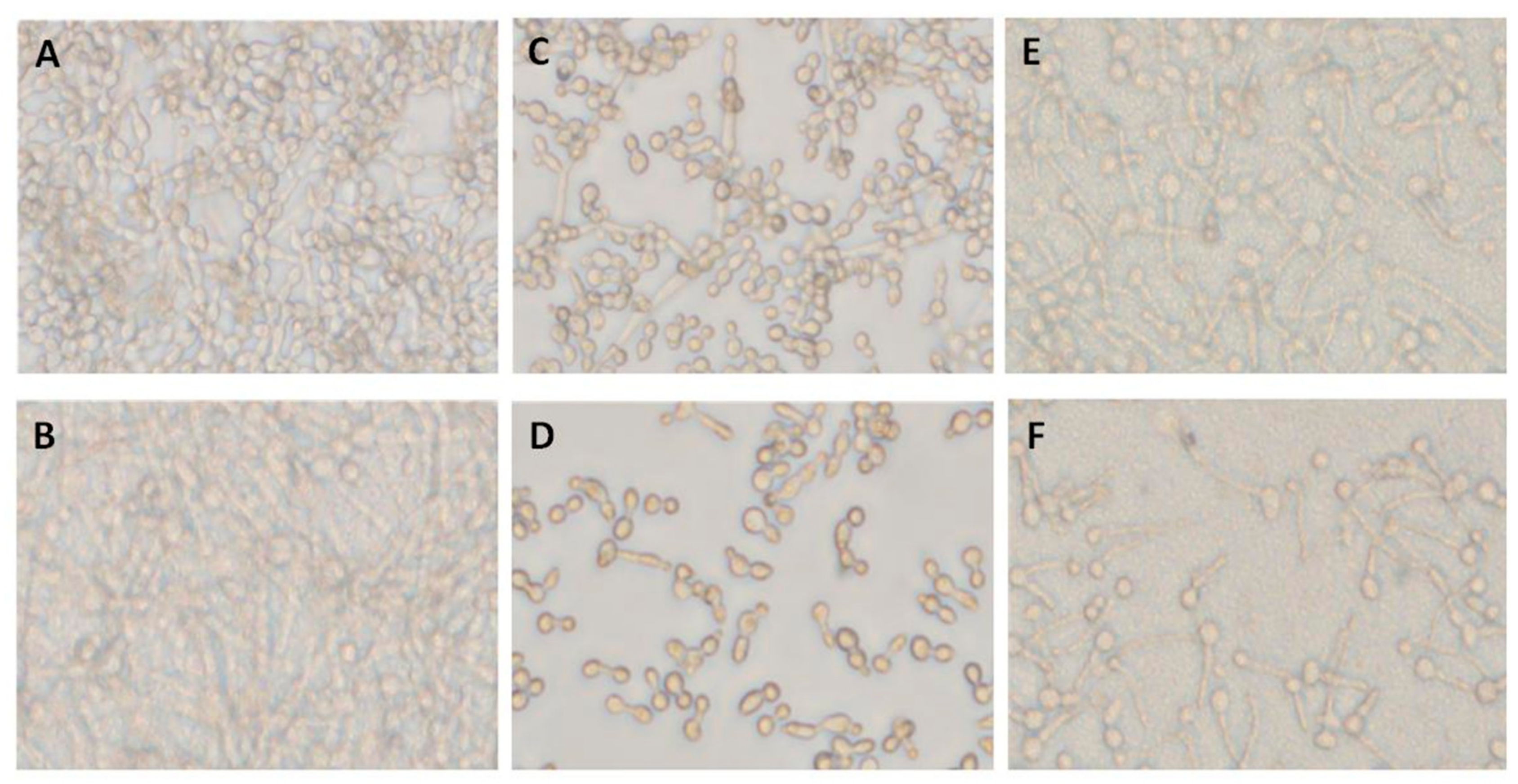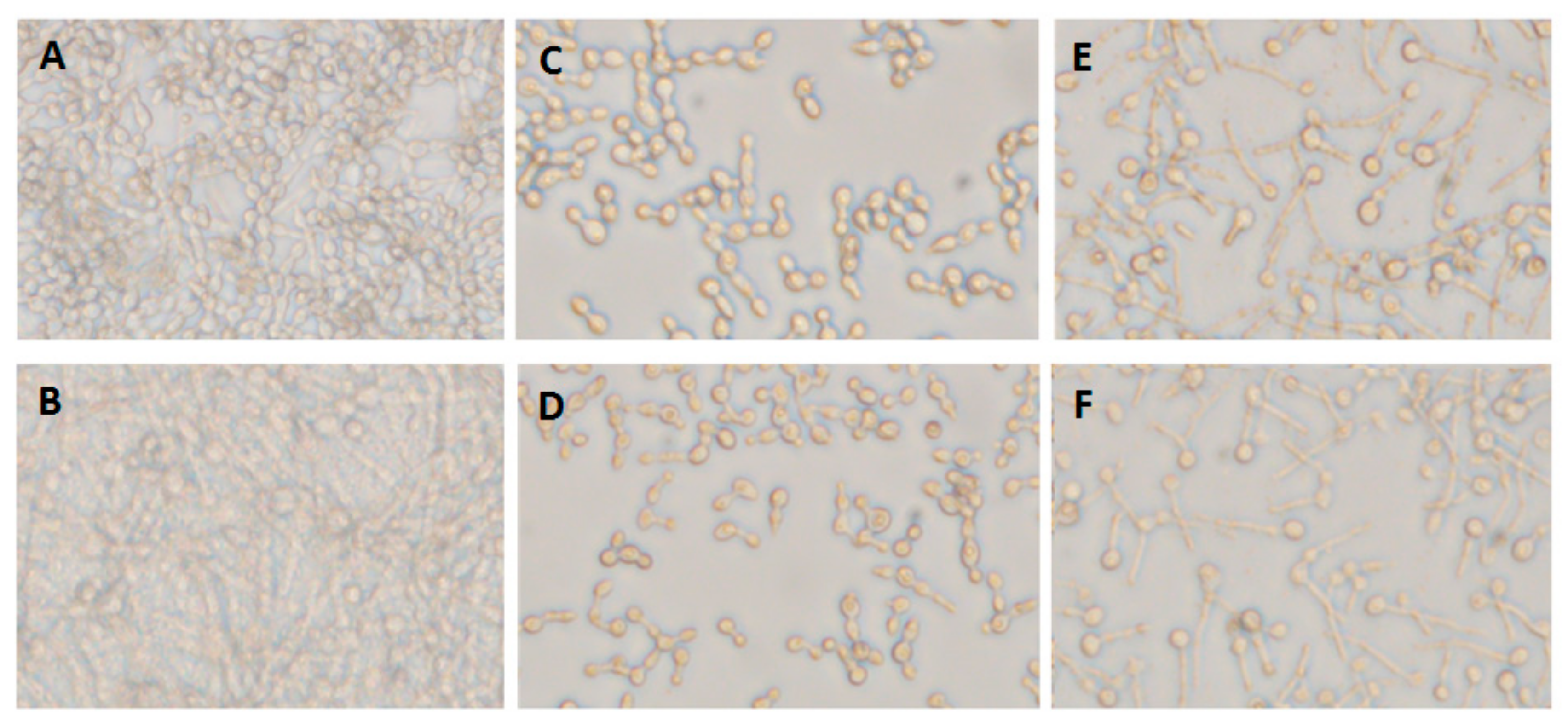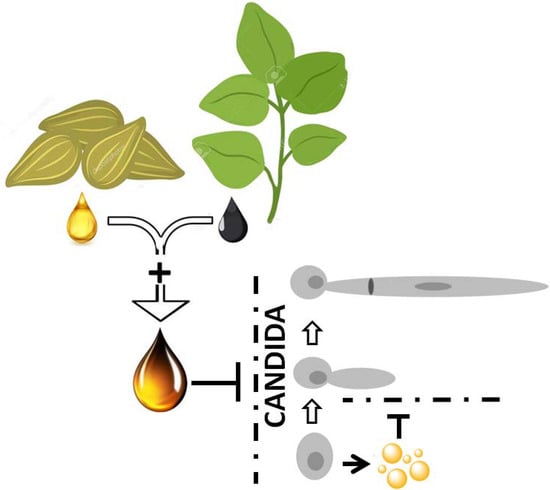Optimum Inhibition of Amphotericin-B-Resistant Candida albicans Strain in Single- and Mixed-Species Biofilms by Candida and Non-Candida Terpenoids
Abstract
:1. Introduction
2. Materials and Methods
2.1. Bacteria and Candida Strains
2.2. Determination of the Minimum Inhibitory Concentration (MIC)
2.3. Determination of the Minimum Fungicidal/Bactericidal Concentrations (MFC/MBC)
2.4. Antimicrobial Activity of Terpenoidal Compounds Combinations against C. albicans and Bacteria
2.5. Inhibition of Single-Species and Mixed-Species Biofilm Formation
2.6. MTT Assay
2.7. Effect of Terpenoidal Compounds on C. albicans Cell Morphology Using Light Microscopy
2.8. Statistical Analysis
2.9. Ethics Statement
3. Results
3.1. Amphotricin-B-Resistant C. albicans Clinical Isolates
3.2. C. albicans Inhibition by Endogenous Terpenoid (Farnesol) Was Hyphae-Phenotype-Specific
3.3. C. albicans Inhibition by Plant Terpenoids
3.4. Inhibition of Single- and Mixed-Species (C. albicans/bacteria) Biofilms by Plant Terpenoids
3.5. Optimum Inhibition of C. albicans by Combination of Yeast and Plant Terpenoids
4. Discussion
5. Conclusions
Supplementary Materials
Author Contributions
Funding
Acknowledgments
Conflicts of Interest
References
- Geffers, C.; Gastmeier, P. Nosocomial infections and multidrug-resistant organisms in Germany: Epidemiological data from kiss (the hospital infection surveillance system). Dtsch. Arztebl. Int. 2011, 108, 87–93. [Google Scholar] [CrossRef] [PubMed]
- Wenzel, R.P.; Gennings, C. Bloodstream Infections Due to Candida Species in the Intensive Care Unit: Identifying Especially High-Risk Patients to Determine Prevention Strategies. Clin. Infect. Dis. 2005, 41, 389–393. [Google Scholar] [CrossRef] [PubMed]
- Sydnor, E.R.M.; Perl, T.M. Hospital Epidemiology and Infection Control in Acute-Care Settings. Clin. Microbiol. Rev. 2011, 24, 141–173. [Google Scholar] [CrossRef] [PubMed] [Green Version]
- Elewski, B.E. Onychomycosis: Pathogenesis, Diagnosis, and Management. Clin. Microbiol. Rev. 1998, 11, 415–429. [Google Scholar] [CrossRef] [Green Version]
- Edwards, J.E.; Lehrer, R.I.; Stiehm, E.R.; Fischer, T.J.; Young, L.S. Severe Candidal Infections. Ann. Intern. Med. 1978, 89, 91–106. [Google Scholar] [CrossRef]
- Brand, A. Hyphal Growth in Human Fungal Pathogens and Its Role in Virulence. Int. J. Microbiol. 2011, 2012, 1–11. [Google Scholar] [CrossRef] [Green Version]
- Choi, J.Y.; Kwak, Y.G.; Yoo, H.; Lee, S.-O.; Kim, H.B.; Han, S.H.; Choi, H.J.; Kim, H.Y.; Kim, S.R.; Kim, T.H. Trends in the distribution and antimicrobial susceptibility of causative pathogens of device-associated infection in Korean intensive care units from 2006 to 2013: Results from the Korean Nosocomial Infections Surveillance System (KONIS). J. Hosp. Infect. 2016, 92, 363–371. [Google Scholar] [CrossRef]
- Cavalheiro, M.; Teixeira, M.C. Candida Biofilms: Threats, Challenges, and Promising Strategies. Front. Med. 2018, 5, 28. [Google Scholar] [CrossRef] [Green Version]
- Elving, G.J.; Van Der Mei, H.C.; Van Weissenbruch, R.; Busscher, H.J.; Albers, F.W.J. Comparison of the microbial composition of voice prosthesis biofilms from patients requiring frequent versus infrequent replacement. Ann. Otol. Rhinol. Laryngol. 2002, 111, 200–203. [Google Scholar] [CrossRef]
- Peleg, A.Y.; Hogan, D.A.; Mylonakis, E. Medically important bacterial–fungal interactions. Nat. Rev. Genet. 2010, 8, 340–349. [Google Scholar] [CrossRef]
- Zhu, J.; Krom, B.P.; Sanglard, D.; Intapa, C.; Dawson, C.C.; Peters, B.M.; Shirtliff, M.E.; Jabra-Rizk, M.A. Farnesol-induced apoptosis in Candida albicans is mediated by Cdr1-p extrusion and depletion of intracellular glutathione. PLoS ONE 2011, 6, e28830. [Google Scholar] [CrossRef] [PubMed] [Green Version]
- Alalwan, H.K.A.; Rajendran, R.; Lappin, D.F.; Combet, E.; Shahzad, M.; Robertson, D.; Nile, C.J.; Williams, C.; Ramage, G. The Anti-Adhesive Effect of Curcumin on Candida albicans Biofilms on Denture Materials. Front. Microbiol. 2017, 8, 588. [Google Scholar] [CrossRef] [PubMed]
- Alviano, W.; Mendonca-Filho, R.R.; Bizzo, H.R.; Souto-Padrón, T.; Rodrigues, M.L.; Bolognese, A.M.; Souza, M.M.G. Antimicrobial activity of Croton cajucara Benth linalool-rich essential oil on artificial biofilms and planktonic microorganisms. Oral Microbiol. Immunol. 2005, 20, 101–105. [Google Scholar] [CrossRef] [PubMed]
- Soliman, S.S.M.; Semreen, M.H.; El-Keblawy, A.A.; Abdullah, A.; Uppuluri, P.; Ibrahim, A.S. Assessment of herbal drugs for promising anti-Candida activity. BMC Complement. Altern. Med. 2017, 17, 257. [Google Scholar] [CrossRef] [PubMed] [Green Version]
- Raut, J.S.; Shinde, R.B.; Chauhan, N.M.; Mohan Karuppayil, S. Terpenoids of plant origin inhibit morphogenesis, adhesion, and biofilm formation by Candida albicans. Biofouling 2013, 29, 87–96. [Google Scholar] [CrossRef] [PubMed]
- Gilabert, M.; Marcinkevicius, K.; Andujar, S.; Schiavone, M.; Arena, M.E.; Bardón, A. Sesqui- and triterpenoids from the liverwort Lepidozia chordulifera inhibitors of bacterial biofilm and elastase activity of human pathogenic bacteria. Phytomedicine 2015, 22, 77–85. [Google Scholar] [CrossRef]
- Amaya, S.; Pereira, J.A.; Borkosky, S.A.; Valdez, J.C.; Bardón, A.; Arena, M.E. Inhibition of quorum sensing in Pseudomonas aeruginosa by sesquiterpene lactones. Phytomedicine 2012, 19, 1173–1177. [Google Scholar] [CrossRef]
- Touil, H.F.Z.; Boucherit-Otmani, Z.; Boucherit, K. In vitro activity of antifungal combinations against planktonic and sessile cells of Candida albicans isolated from medical devices in an intensive care department. J. Mycol. Med. 2018, 28, 414–418. [Google Scholar] [CrossRef]
- CLSI. Clinical and Laboratory Standards Institute. In M27, Reference Method for Broth Dilution Antifungal Susceptibility Testing of Yeasts, 3rd ed.; Clinical and Laboratory Standards Institute: Wayne, NJ, USA, 2017. [Google Scholar]
- CLSI. Clinical and Laboratory Standards Institute. In M07, Methods for Dilution Antimicrobial Susceptibility Tests for Bacteria That Grow Aerobically, 10th ed.; Clinical Laboratory Standards Institute: Wayne, NJ, USA, 2017. [Google Scholar]
- Weerasekera, M.M.; Wijesinghe, G.K.; Jayarathna, T.A.; Gunasekara, C.P.; Fernando, N.; Kottegoda, N.; Samaranayake, L.P. Culture media profoundly affect Candida albicans and Candida tropicalis growth, adhesion and biofilm development. Mem. Inst. Oswaldo Cruz. 2016, 111, 697–702. [Google Scholar] [CrossRef] [Green Version]
- Fernandes, R.A.; Monteiro, D.R.; Arias, L.S.; Fernandes, G.L.; Delbem, A.C.B.; Barbosa, D.B. Biofilm formation by Candida albicans and Streptococcus mutans in the presence of farnesol: A quantitative evaluation. Biofouling 2016, 32, 329–338. [Google Scholar] [CrossRef] [Green Version]
- Espinel-Ingroff, A.; Fothergill, A.; Peter, J.; Rinaldi, M.; Walsh, T. Testing conditions for determination of minimum fungicidal concentrations of new and established antifungal agents for Aspergillus spp.: NCCLS collaborative study. J. Clin. Microbiol. 2002, 40, 3204–3208. [Google Scholar] [CrossRef] [PubMed] [Green Version]
- Johnson, M.; MacDougall, C.; Ostrosky-Zeichner, L.; Perfect, J.R.; Rex, J. Combination Antifungal Therapy. Antimicrob. Agents Chemother. 2004, 48, 693–715. [Google Scholar] [CrossRef] [PubMed] [Green Version]
- Ibarra-Trujillo, C.; Villar-Vidal, M.; Gaitán-Cepeda, L.A.; Pozos-Guillen, A.; Mendoza-de Elias, R.; Sánchez-Vargas, L.O. Ensayo de formación y cuantificación de biopelículas mixtas de Candida albicans y Staphylococcus aureus. Revista Iberoam. Micol. 2012, 29, 214–222. [Google Scholar] [CrossRef] [PubMed]
- ATCC.org. MTT Cell Proliferation Assay. Available online: http://www.atcc.org/~/media/DA5285A1F52C414E864C966FD78C9A79.ashx (accessed on 17 March 2019).
- Brescia, P.; Banks, P. Quantifying Cytotoxicity of Thiostrepton on Mesothelioma Cells Using MTT Assay and the Epoch™ Microplate Spectrophotometer; BioTek Instruments, INC.: Winooski, VT, USA, 2009. [Google Scholar]
- Meletiadis, J.; Mouton, J.W.; Meis, J.F.; Verweij, P.E. In vitro drug interaction modeling of combinations of azoles with terbinafine against clinical Scedosporium prolificans isolates. Antimicrob. Agents Chemother. 2003, 47, 106–117. [Google Scholar] [CrossRef] [Green Version]
- Cordeiro, R.A.; Teixeira, C.E.C.; Brilhante, R.S.N.; Castelo-Branco, D.; Paiva, M.A.N.; Leite, J.J.G.; Lima, D.T.; Monteiro, A.J.; Sidrim, J.J.C.; Rocha, M.F.G. Minimum inhibitory concentrations of amphotericin B, azoles and caspofungin againstCandidaspecies are reduced by farnesol. Med. Mycol. 2013, 51, 53–59. [Google Scholar] [CrossRef] [Green Version]
- Shanmughapriya, S.; Sornakumari, H.; Lency, A.; Kavitha, S.; Natarajaseenivasan, K. Synergistic effect of amphotericin B and tyrosol on biofilm formed by Candida krusei and Candida tropicalis from intrauterine device users. Med. Mycol. 2014, 52, 853–861. [Google Scholar] [CrossRef] [Green Version]
- Bozó, A.; Domán, M.; Majoros, L.; Kardos, G.; Varga, I.; Kovács, R. The in vitro and in vivo efficacy of fluconazole in combination with farnesol against Candida albicans isolates using a murine vulvovaginitis model. J. Microbiol. 2016, 54, 753–760. [Google Scholar] [CrossRef]
- Hirakawa, M.; Martinez, D.A.; Sakthikumar, S.; Anderson, M.Z.; Berlin, A.; Gujja, S.; Zeng, Q.; Zisson, E.; Wang, J.M.; Greenberg, J.M.; et al. Genetic and phenotypic intra-species variation in Candida albicans. Genome Res. 2014, 25, 413–425. [Google Scholar] [CrossRef] [Green Version]
- Monteiro, D.; Arias, L.; Fernandes, R.; Da Silva, L.D.; De Castilho, M.; Da Rosa, T.; Vieira, A.; Straioto, F.; Barbosa, D.B.; Delbem, A.C.B. Antifungal activity of tyrosol and farnesol used in combination against Candida species in the planktonic state or forming biofilms. J. Appl. Microbiol. 2017, 123, 392–400. [Google Scholar] [CrossRef]
- Hittinger, C.T.; Rokas, A.; Bai, F.-Y.; Boekhout, T.; Gonçalves, P.; Jeffries, T.W.; Kominek, J.; Lachance, M.-A.; Libkind, D.; Rosa, C.A.; et al. Genomics and the making of yeast biodiversity. Curr. Opin. Genet. Dev. 2015, 35, 100–109. [Google Scholar] [CrossRef] [Green Version]
- Ramage, G.; Saville, S.P.; Wickes, B.L.; López-Ribot, J.L. Inhibition of Candida albicans Biofilm Formation by Farnesol, a Quorum-Sensing Molecule. Appl. Environ. Microbiol. 2002, 68, 5459–5463. [Google Scholar] [CrossRef] [PubMed] [Green Version]
- Nickerson, K.W.; Atkin, A.L.; Hornby, J.M. Quorum Sensing in Dimorphic Fungi: Farnesol and Beyond. Appl. Environ. Microbiol. 2006, 72, 3805–3813. [Google Scholar] [CrossRef] [PubMed] [Green Version]
- Polke, M.; Leonhardt, I.; Kurzai, O.; Jacobsen, I. Farnesol signalling inCandida albicans– more than just communication. Crit. Rev. Microbiol. 2017, 44, 230–243. [Google Scholar] [CrossRef] [PubMed]
- Langford, M.L.; Atkin, A.; Nickerson, K.W. Cellular interactions of farnesol, a quorum-sensing molecule produced byCandida albicans. Futur. Microbiol. 2009, 4, 1353–1362. [Google Scholar] [CrossRef]
- Uppuluri, P.; Mekala, S.; Chaffin, W.L. Farnesol-mediated inhibition ofCandida albicansyeast growth and rescue by a diacylglycerol analogue. Yeast 2007, 24, 681–693. [Google Scholar] [CrossRef] [PubMed]
- Dumitru, R.; Navarathna, D.H.M.L.P.; Semighini, C.P.; Elowsky, C.G.; Dumitru, R.V.; Dignard, D.; Whiteway, M.; Atkin, A.L.; Nickerson, K.W. In Vivo and In Vitro Anaerobic Mating in Candida albicans. Eukaryot. Cell 2007, 6, 465–472. [Google Scholar] [CrossRef] [Green Version]
- Dižová, S.; Bujdáková, H. Properties and role of the quorum sensing molecule farnesol in relation to the yeast Candida albicans. Pharmazie 2017, 72, 307–312. [Google Scholar]
- Fernandes, R.A.; Monteiro, D.; Arias, L.S.; Fernandes, G.L.; Delbem, A.C.B.; Barbosa, D.B. Virulence Factors in Candida albicans and Streptococcus mutans Biofilms Mediated by Farnesol. Indian J. Microbiol. 2018, 58, 138–145. [Google Scholar] [CrossRef] [Green Version]
- Chaillot, J.; Tebbji, F.; Remmal, A.; Boone, C.; Brown, G.W.; Bellaoui, M.; Sellam, A. The Monoterpene Carvacrol Generates Endoplasmic Reticulum Stress in the Pathogenic Fungus Candida albicans. Antimicrob. Agents Chemother. 2015, 59, 4584–4592. [Google Scholar] [CrossRef] [Green Version]
- Rao, A.; Zhang, Y.; Muend, S.; Rao, R. Mechanism of Antifungal Activity of Terpenoid Phenols Resembles Calcium Stress and Inhibition of the TOR Pathway. Antimicrob. Agents Chemother. 2010, 54, 5062–5069. [Google Scholar] [CrossRef] [Green Version]
- Ahmad, A.; Khan, A.; Akhtar, F.; Yousuf, S.; Xess, I.; Khan, L.A.; Manzoor, N. Fungicidal activity of thymol and carvacrol by disrupting ergosterol biosynthesis and membrane integrity against Candida. Eur. J. Clin. Microbiol. Infect. Dis. 2010, 30, 41–50. [Google Scholar] [CrossRef] [PubMed]
- Chami, N.; Bennis, S.; Chami, F.; Aboussekhra, A.; Remmal, A. Study of anticandidal activity of carvacrol and eugenol in vitro and in vivo. Oral Microbiol. Immunol. 2005, 20, 106–111. [Google Scholar] [CrossRef] [PubMed]
- Cassella, J. Synergistic antifungal activity of tea tree (Melaleuca alternifolia) and lavender (Lavandula angustifolia) essential oils against dermatophyte infection. Int. J. Aromather. 2002, 12, 2–15. [Google Scholar] [CrossRef]
- De Rapper, S.; Kamatou, G.; Viljoen, A.; Van Vuuren, S. The In Vitro Antimicrobial Activity of Lavandula angustifolia Essential Oil in Combination with Other Aroma-Therapeutic Oils. Evidence Based Complement. Altern. Med. 2013, 2013, 1–10. [Google Scholar] [CrossRef] [PubMed] [Green Version]
- Pauli, A. Anticandidal low molecular compounds from higher plants with special reference to compounds from essential oils. Med. Res. Rev. 2006, 26, 223–268. [Google Scholar] [CrossRef]
- Marcos-Arias, C.; Eguia, A.; Madariaga-Torres, L.; Quindós, G. In vitro activities of natural products against oral Candida isolates from denture wearers. BMC Complement. Altern. Med. 2011, 11, 119. [Google Scholar] [CrossRef] [Green Version]
- Gallucci, M.; Carezzano, M.; Oliva, M.; Demo, M.; Pizzolitto, R.; Zunino, M.; Zygadlo, J.A.; Dambolena, J.S. In vitroactivity of natural phenolic compounds against fluconazole-resistantCandidaspecies: A quantitative structure-activity relationship analysis. J. Appl. Microbiol. 2014, 116, 795–804. [Google Scholar] [CrossRef]
- Inouye, S.; Takahashi, M.; Abe, S. Inhibitory activity of hydrosols, herbal teas and related essential oils against filament formation and the growth of Candida albicans. Nippon. Ishinkin Gakkai Zasshi 2009, 50, 243–251. [Google Scholar] [CrossRef] [Green Version]
- Adam, B.; Baillie, G.S.; Douglas, L.J. Mixed species biofilms of Candida albicans and Staphylococcus epidermidis. J. Med Microbiol. 2002, 51, 344–349. [Google Scholar] [CrossRef] [Green Version]
- Hawser, S.P.; Douglas, L.J. Resistance of Candida albicans biofilms to antifungal agents in vitro. Antimicrob. Agents Chemother. 1995, 39, 2128–2131. [Google Scholar] [CrossRef] [Green Version]
- Seddiki, S.; Boucherit-Otmani, Z.; Boucherit, K.; Kunkel, D. Fungal infectivities of implanted catheters due to Candida sp. Biofilms formation and resistance. J. Mycol. Med. 2015, 25, 130–135. [Google Scholar] [CrossRef] [PubMed]
- Douglas, L.J. Candida biofilms and their role in infection. Trends Microbiol. 2003, 11, 30–36. [Google Scholar] [CrossRef]
- Amber, K.; Aijaz, A.; Immaculata, X.; Luqman, K.; Nikhat, M. Anticandidal effect of Ocimum sanctum essential oil and its synergy with fluconazole and ketoconazole. Phytomedicine 2010, 17, 921–925. [Google Scholar] [CrossRef] [PubMed]
- Khan, M.S.A.; Ahmad, I. Antibiofilm activity of certain phytocompounds and their synergy with fluconazole against Candida albicans biofilms. J. Antimicrob. Chemother. 2011, 67, 618–621. [Google Scholar] [CrossRef]
- Doke, S.K.; Raut, J.S.; Dhawale, S.; Karuppayil, S.M. Sensitization of Candida albicans biofilms to fluconazole by terpenoids of plant origin. J. Gen. Appl. Microbiol. 2014, 60, 163–168. [Google Scholar] [CrossRef] [Green Version]
- Magi, G.; Marini, E.; Facinelli, B. Antimicrobial activity of essential oils and carvacrol, and synergy of carvacrol and erythromycin, against clinical, erythromycin-resistant Group A Streptococci. Front. Microbiol. 2015, 6, 165. [Google Scholar] [CrossRef] [Green Version]
- Tsai, K.-D.; Liu, Y.-H.; Chen, T.; Yang, S.-M.; Wong, H.-Y.; Cherng, J.; Chou, K.-S.; Cherng, J.-M. Cuminaldehyde from Cinnamomum verum Induces Cell Death through Targeting Topoisomerase 1 and 2 in Human Colorectal Adenocarcinoma COLO 205 Cells. Nutrients 2016, 8, 318. [Google Scholar] [CrossRef] [Green Version]





| Candida | Bacteria | ||
|---|---|---|---|
| Strain | Symbol | Strain | Symbol |
| Candida albicans 1 | A1 | Escherichia coli | Ec2 |
| Candida albicans 2 | A2 | Escherichia coli | Ec4 |
| Candida albicans 3 | A3 | Escherichia coli | Ec13 |
| Candida albicans 4 | A4 | Providencia stuartii | Ps2 |
| Candida albicans 5 | A5 | Providencia stuartii | Ps3 |
| Candida albicans 6 | A6 | Acinetobacter baumannii | Ab7 |
| Candida albicans 7 | A7 | Acinetobacter baumannii | Ab11 |
| Candida albicans 8 | A8 | Proteus mirabilis | Pm16 |
| Candida albicans 9 | A9 | Proteus mirabilis | Pm18 |
| Candida albicans 10 | A10 | Proteus mirabilis | Pm19 |
| Candida albicans 11 | A11 | Proteus mirabilis | Pm21 |
| Candida albicans 12 | A12 | Staphylococcus aureus | Sa6 |
| Candida albicans 13 | A13 | Staphylococcus aureus | Sa11 |
| Candida albicans 14 | A14 | Staphylococcus aureus | Sa24 |
| Candida albicans 15 | A15 | Staphylococcus epidermidis | Se3 |
| Candida albicans | ATCC10231 | ||
| Strains | MIC (mg/mL) | FICI* | Interactions | ||
|---|---|---|---|---|---|
| Carvacrol | Farnesol | Carvacrol/Farnesol | |||
| ATCC10231 | 0.5 | 150 | 0.03 + 0.2 | 0.06 | Synergy |
| A1 | 0.5 | 16.8 | 0.125 + 1.2 | 0.33 | Synergy |
| A2 | 0.5 | 33.6 | 0.03 + 1.2 | 0.10 | Synergy |
| A3 | 1 | 33.6 | 0.06 + 0.2 | 0.06 | Synergy |
| A4 | 0.25 | 33.6 | 0.03 + 0.4 | 0.13 | Synergy |
| A5 | 1 | 33.6 | 0.125 + 1.2 | 0.17 | Synergy |
| A6 | 0.5 | 33.6 | 0.06 + 1.2 | 0.16 | Synergy |
| A7 | 0.5 | 33.6 | 0.125 + 0.4 | 0.26 | Synergy |
| A8 | 1 | 16.8 | 0.25 + 0.4 | 0.28 | Synergy |
| A9 | 1 | 33.6 | 0.25 + 0.4 | 0.26 | Synergy |
| A10 | 0.5 | 33.6 | 0.06 + 0.8 | 0.15 | Synergy |
| A11 | 1 | 33.6 | 0.25 + 0.8 | 0.28 | Synergy |
| A12 | 0.5 | 33.6 | 0.125 + 1.2 | 0.29 | Synergy |
| A13 | 1 | 33.6 | 0.25 + 0.8 | 0.28 | Synergy |
| A14 | 0.5 | 16.8 | 0.125 + 1.2 | 0.33 | Synergy |
| A15 | 1 | 33.6 | 0.125 + 1.2 | 0.15 | Synergy |
© 2020 by the authors. Licensee MDPI, Basel, Switzerland. This article is an open access article distributed under the terms and conditions of the Creative Commons Attribution (CC BY) license (http://creativecommons.org/licenses/by/4.0/).
Share and Cite
Touil, H.F.Z.; Boucherit, K.; Boucherit-Otmani, Z.; Kohder, G.; Madkour, M.; Soliman, S.S.M. Optimum Inhibition of Amphotericin-B-Resistant Candida albicans Strain in Single- and Mixed-Species Biofilms by Candida and Non-Candida Terpenoids. Biomolecules 2020, 10, 342. https://doi.org/10.3390/biom10020342
Touil HFZ, Boucherit K, Boucherit-Otmani Z, Kohder G, Madkour M, Soliman SSM. Optimum Inhibition of Amphotericin-B-Resistant Candida albicans Strain in Single- and Mixed-Species Biofilms by Candida and Non-Candida Terpenoids. Biomolecules. 2020; 10(2):342. https://doi.org/10.3390/biom10020342
Chicago/Turabian StyleTouil, Hidaya F. Z., Kebir Boucherit, Zahia Boucherit-Otmani, Ghalia Kohder, Mohamed Madkour, and Sameh S. M. Soliman. 2020. "Optimum Inhibition of Amphotericin-B-Resistant Candida albicans Strain in Single- and Mixed-Species Biofilms by Candida and Non-Candida Terpenoids" Biomolecules 10, no. 2: 342. https://doi.org/10.3390/biom10020342
APA StyleTouil, H. F. Z., Boucherit, K., Boucherit-Otmani, Z., Kohder, G., Madkour, M., & Soliman, S. S. M. (2020). Optimum Inhibition of Amphotericin-B-Resistant Candida albicans Strain in Single- and Mixed-Species Biofilms by Candida and Non-Candida Terpenoids. Biomolecules, 10(2), 342. https://doi.org/10.3390/biom10020342






